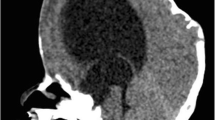Abstract
Refractory pleural effusion can be a life-threatening complication in patients receiving maintenance hemodialysis. We report successful treatment of refractory pleural effusion using a Denver® pleuroperitoneal shunt in one such patient. A 54-year-old Japanese man, who had previously undergone left nephrectomy, was admitted urgently to our department because of a high C-reactive protein (CRP) level, right pleural effusion, and right renal abscess. Because antibiotics proved ineffective and his general state was deteriorating, he underwent emergency insertion of a thoracic drainage tube and nephrectomy, and hemodialysis was started. Although his general state improved slowly thereafter, the pleural effusion, which was unilateral and transudative, remained refractory and therefore he needed to be on oxygenation. To control the massive pleural effusion, a pleuroperitoneal shunt was inserted. Thereafter, his respiratory condition became stable without oxygenation and he was discharged. His general condition has since been well. Although pleural effusion is a common complication of maintenance hemodialysis, few reports have documented the use of pleuroperitoneal shunt to control refractory pleural effusion. Pleuroperitoneal shunt has been advocated as an effective and low-morbidity treatment for refractory pleural effusion, and its use for some patients with recurrent pleural effusion has also been reported, without any severe complications. In the present case, pleuroperitoneal shunt improved the patient’s quality of life sufficiently to allow him to be discharged home without oxygenation. Pleuroperitoneal shunt should be considered a useful treatment option for hemodialysis patients with refractory pleural effusion.


Similar content being viewed by others
References
Bakirci T, Sasak G, Ozturk S, Akcay S, Sezer S, Haberal M. Pleural effusion in long-term hemodialysis patients. Transpl Proc. 2007;39(4):889 – 91.
Rashid-Farokhi F, Pourdowlat G, Nikoonia MR, Behzadnia N, Kahkouee S, Nassiri AA, Masjedi MR. Uremic pleuritis in chronic hemodialysis patients. Hemodial Int. 2013;17(1):94–100. https://doi.org/10.1111/j.1542-4758.2012.00722.x (Epub 2012 Jun 20).
© 2011 CareFusion Corporation or one of its subsidiaries. All rights reserved. Denver and Silique are trademarks or registered trademarks of CareFusion Corporation or one of its subsidiaries. LIT12007en-ED01. https://www.bd.com/Documents/international/brochures/interventionalspecialties/IS_Denver-ascites-shunts_BR_EN.pdf
Jarratt MJ, Sahn SA. Pleural effusions in hospitalized patients receiving long-term hemodialysis. Chest. 1995;108(2):470–4.
Maher JF. Uremic pleuritis. Am J Kidney Dis. 1987;10(1):19–22.
Al-Harby A, Al-Furayh O, Al-Dayel F, Al-Mobeireek A. Pleural effusion in a patient with end-stage renal disease. Ann Saudi Med. 2006;26(2):145–6.
Light RW, Macgregor MI, Luchsinger PC, Ball WC Jr. Pleural effusions: the diagnostic separation of transudates and exudates. Ann Intern Med. 1972;77(4):507–13.
Wong CL, Holroyd-Leduc J, Straus SE. Does this patient have a pleural effusion? JAMA. 2009;301(3):309–17. https://doi.org/10.1001/jama.2008.937.
Petrou M, Kaplan D, Goldstraw P. Management of recurrent malignant pleural effusions. The complementary role talc pleurodesis and pleuroperitoneal shunting. Cancer.1995;75(3):801–5.
Ponn RB, Blancaflor J, D’Agostino RS, Kiernan ME, Toole AL, Stern H, et al. Pleuroperitoneal shunting for intractable pleural effusions. Ann Thorac Surg. 1991;51(4):605–9.
Little AG, Ferguson MK, Golomb HM, Hoffman PC, Vogelzang NJ, Skinner DB, et al. Pleuroperitoneal shunting for malignant pleural effusions. Cancer. 1986;58(12):2740–3.
Cimochowski GE, Joyner LR, Fardin R, Sarama R, Maran A. Pleuroperitoneal shunting for recalcitrant pleural effusions. J Thorac Cardiovasc Surg. 1986;92(5):866 – 70.
Little AG1, Kadowaki MH, Ferguson MK, Staszek VM, Skinner DB. Pleuro-peritoneal shunting. Alternative therapy for pleural effusions. Ann Surg. 1988;208(4):443–50.
Murphy MC1, Newman BM, Rodgers BM. Pleuroperitoneal shunts in the management of persistent chylothorax. Ann Thorac Surg. 1989;48(2):195–200.
Milsom JW, Kron IL, Rheuban KS, Rodgers BM. Chylothorax: an assessment of current surgical management. J Thorac Cardiovasc Surg. 1985;89(2):221–7.
Genc O, Petrou M, Ladas G, Goldstraw P. The long-term morbidity of pleuroperitoneal shunts in the management of recurrent malignant effusions. Eur J Cardiothorac Surg. 2000;18(2):143–6.
Tzeng E, Ferguson MK. Predicting failure following shunting of pleural effusions. Chest. 1990;98(4):890–3.
Aydin Y, Turkyilmaz A, Intepe YS, Eroglu A. Malignant pleural effusions: appropriate treatment approaches. Eurasian J Med. 2009;41(3):186–93.
Acknowledgements
We would like to thank all of the medical staff who managed this patient at our Division of Clinical Nephrology and Rheumatology.
Funding
No funding was received for this study.
Author information
Authors and Affiliations
Contributions
MH, TI, YY, KM, SM, DK, and HK were involved in the clinical care of the patient, managed the literature searches, and wrote the first draft of the manuscript. IN helped to draft the manuscript. All authors read and approved the final version.
Corresponding author
Ethics declarations
Conflict of interest
The authors declare that they have no competing interests.
Ethical approval and consent
Not applicable.
Consent for publication
Written informed consent was obtained from the patient for publication of this case report and any accompanying images.
Availability of data and material
The dataset supporting the conclusions of this article was included within the article and its additional file.
About this article
Cite this article
Habuka, M., Ito, T., Yoshizawa, Y. et al. Usefulness of a pleuroperitoneal shunt for treatment of refractory pleural effusion in a patient receiving maintenance hemodialysis. CEN Case Rep 7, 189–194 (2018). https://doi.org/10.1007/s13730-018-0323-4
Received:
Accepted:
Published:
Issue Date:
DOI: https://doi.org/10.1007/s13730-018-0323-4




